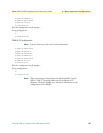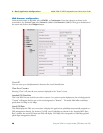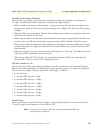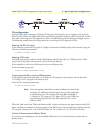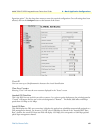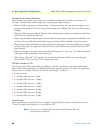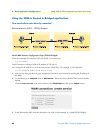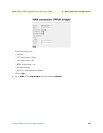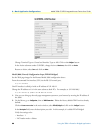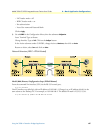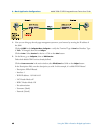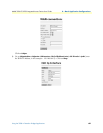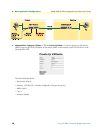
TDM Plus Ethernet Traffic 63
Model 3086 G.SHDSL Integrated Access Device User Guide 4 • Basic Application Configurations
Interface Type
Selects between HDLC or ATM transports. This setting must match the transport selected in the “WAN con-
nection” menu. When using the 3086 to transport serial data only, select HDLC transport.
PCM Mode
The PCM mode selection tells the Model 3086 whether the DSL link will carry Serial data (from serial port),
Ethernet data (from Ethernet port), or both Serial and Ethernet. Make sure to assign bandwidth to the serial
port in the “Intended Serial Interface Data Rate” when selecting “Serial” or “Serial and Ethernet” traffic.
Clocking Options
When using the serial port, the 3086 can transmit to the attached DTE using its internal clock, or using exter-
nal clock from the DTE (this option is only available to units set for “Central”). Most applications use internal
clock.
PCM Transmit Polarity
When using long cables on the serial port side, it is possible that the clock and data arriving at the DTE may be
out of synchronization, causing data errors. Inverting the polarity of the transmit clock at the 3086 may solve
this problem. Use the “Normal” setting when using short serial cables (less than 6 feet or 1.8 meters).
PCM Receive Polarity
When using long cables on the serial port side, it is possible that the clock and data arriving at the 3086 may be
out of synchronization, causing data errors. Inverting the polarity of the receive clock at the 3086 may solve
this problem. Use the “Normal” setting when using short serial cables (less than 6 feet or 1.8 meters).
Loopback
The 3086 uses a series of loopbacks to test the serial, Ethernet, and DSL links, Refer to Chapter 9, “Diagnos-
tics” on page 135 for more information.
Annex Type
Annex type refers to spectral compatibility between DSL and T1 or E1 signals. For North America and other
areas where T1 lines are used, select Annex A, for areas where E1 lines are used select Annex B.
Line Probe
Line probe is a tool used to determine maximum achievable rate when initially connecting 3086s to a copper
line of unknown quality. Set this feature to “Enable” on both 3086s at each end of the link. Once line probe
measurements have been completed set this feature to “Disabled”
Once you have completed your selections or changes, click on the
Configure
button at the bottom of the
screen. Additionally, go to the
G.SHDSL > Action
link on the left side of the screen, and click
action
to start the
DSL interface with the new settings.
This concludes the basic DSL configuration for Ethernet and serial ports.
If your application calls for Ethernet only, or Serial and Ethernet traffic you need to configure the Model 3086
Ethernet transport between HDLC or ATM encapsulation. In addition, select between bridged or routed con
-
figuration options, whichever meets your network needs. The following section steps through the various
application configurations options possible with the 3086.



